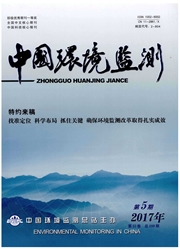

 中文摘要:
中文摘要:
主要对北京西北城区2010年度春季大气可吸入颗粒物的理化特征进行分析研究,通过利用高分辨率场发射扫描电镜和图像分析技术研究了区内可吸入颗粒物的微观形貌类型及百分含量特征,利用扫描电镜及能谱分析研究矿物颗粒的元素组成及富集类型。结果表明,在西北城区春季大气PM10中可识别出烟尘集合体、球形颗粒、矿物和其他未知颗粒等4种单颗粒类型,沙尘暴天气对矿物颗粒的数量比例影响较大,同时影响颗粒物粒度分布。矿物颗粒按成分可分为"富Si"、"富Ca"、"富Fe"、"富S"、"富Na"、"富Ti"、"富Al"、"富Cl"和"富Mg"颗粒九大类,沙尘天气与非沙尘天气的矿物颗粒均以"富Si"颗粒、"富Ca"颗粒、"富Fe"颗粒、"富S"颗粒等为主。
 英文摘要:
英文摘要:
The physico-chemical properties of airborne inhalable particles in the Northwest District of Beijing in spring 2010 during the dust storm was investigated in this study,the morphological types of the individual particles in PM10 was investigated by the high resolution Field Emission Scanning Electron Microscopy and image analyzer,the elemental composition of mineral particles and enrichment type in PM10 was investigated by scanning electron microscopy with energy dispersive X-ray.The results show that the PM10 in the northwestern Beijing in spring 2010 could be subdivided into 4 major categories,including soot aggregates,fly ash,mineral and unresolved particles.Size distribution of PM10 and the proportion of the number of PM10 was affected by dust storm.A total of 9 different mineral categories were classified,namely,"Si-rich","Ca-rich","Fe-rich","S-rich","Na-rich","Ti-rich","Al-rich","Cl-rich" and "Mg-rich".Either in dust storm or in non-dust episodes,the major classes of dust particles were defined as follows: "Si-rich","Ca-rich","Fe-rich","S-rich".
 同期刊论文项目
同期刊论文项目
 同项目期刊论文
同项目期刊论文
 Characteristics and sources of PM in seasonal perspective e A case study from oneyear continuously s
Characteristics and sources of PM in seasonal perspective e A case study from oneyear continuously s Individual particle analysis of aerosols collected under haze and non-haze conditions at a high-elev
Individual particle analysis of aerosols collected under haze and non-haze conditions at a high-elev 期刊信息
期刊信息
